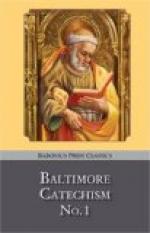“Ransom the captive”—that is, chiefly those who while teaching or defending the true religion in pagan lands are taken prisoners by the enemies of our faith. You have perhaps heard of the Crusades or read about them in your history. Now let me briefly tell you what they were and why they were commenced. About the year 570, that is, about thirteen hundred years ago, when the Christian religion was spread over nearly the whole world, a man named Mahomet was born in Arabia. He pretended to be a great prophet sent from God, and gathered many followers about him. He told them his religion must be spread by the sword. He plundered cities and towns, and divided the spoils with his followers. He told them that all who died fighting for him would certainly go to Heaven. In a short time his followers became very numerous; for his religion was an easy and profitable one, allowing them to commit sin without fear of punishment, and giving them share of his plunder. Many others not influenced by these motives joined his religion for fear of being put to death. His followers were afterwards called by the general name of Saracens. They took possession of the Holy Land, of the City of Jerusalem, of the tomb of Our Lord, and of every spot rendered dear to Christians by Our Saviour’s life and labors there. They persecuted the Christians who went to visit the Holy Land, and put many of them to death. When the news of these dreadful crimes reached Europe, the Christian kings and princes, at the request of the Pope, raised large armies and set out for the East to war against the Saracens and recover the Holy Land. Eight of these expeditions, or Crusades, as they are called, went out during two hundred years, that is, from 1095 to 1272. Those who took part in them are called Crusaders, from the word cross, because every soldier wore a red cross upon his shoulder.
Some of these expeditions were successful, and some were not; but, on the whole, they prevented the Saracens from coming to Europe and taking possession of it. Many of the Christian soldiers and many of the pilgrims who visited the Holy Land were taken prisoners by the Saracens and held, threatened with death, till the Christians in Europe paid large sums of money as a ransom for their liberty. To free these captives was a great act of charity, and is one of the corporal works of mercy. Ransom means to pay money for another’s freedom. Even now there are sometimes captives in pagan lands.
A pilgrim is one who goes on a journey to visit some holy place for the purpose of thus honoring God. He would not be a pilgrim if he went merely through curiosity. He must go with the holy intention of making his visit an act of worship. In our time pilgrimages to the Holy Land, to Rome, and other places are quite frequent. “To harbor”—that is, to give one who has no home a place of rest. A harbor is an inlet of the ocean where ships can rest and be out of danger; so we can also call the




